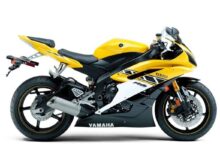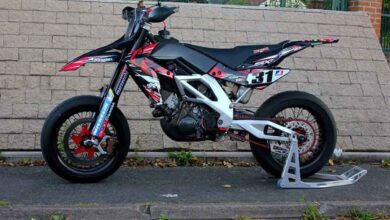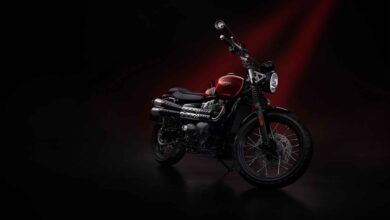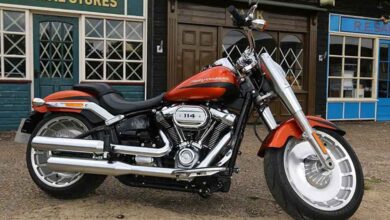The History and Legacy of Suzuki Katana GSX1100
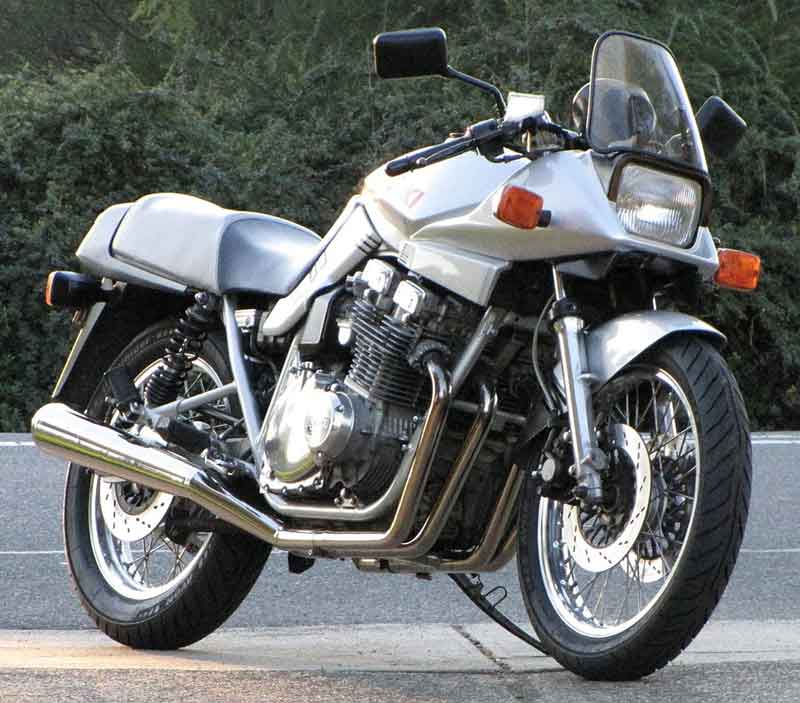
The Suzuki Katana GSX1100 is a motorcycle that was introduced by Suzuki in 1980. The bike quickly gained popularity due to its unique design, which was influenced by the traditional Japanese sword of the same name. The original Katana was powered by an air-cooled, four-stroke, 998cc engine that produced around 90 horsepower. However, in 1981, Suzuki released the GSX1100S Katana with a 1074cc engine that produced around 111 horsepower.
Contents
- 1 Forging a New Street Legend Suzuki Katana GSX1100
- 2 A Cut Above
- 3 Key mascot
- 4 Suzuki Intelligent Ride System (S.I.R.S.)
- 5 The Design of the Suzuki Katana
- 6 Engine Design
- 7 Chassis Design
- 8 Performance of the Suzuki Katana
- 9 Legacy of the Suzuki Katana
- 10 Modifications and Customizations
- 11 Collectibility of the Suzuki Katana
- 12 Electronic Design
- 13 SPECIFICATIONS
- 14 Personalize your ride
- 15 Conclusion
Forging a New Street Legend Suzuki Katana GSX1100

Continued refinement of the 2022 KATANA sharpens its performance and enhances riding pleasure. The updates encompass advanced electronic controls and refinements that improve overall performance. Stylistic enhancements, such as new body colors tailored for a superior street bike and updated trim for functional parts, accentuate its quality and distinctive appearance.
A Cut Above



The epitome of fine craftsmanship and pure functional beauty. The original 1981 Suzuki KATANA drew design inspiration from the renowned Japanese sword that shares its name. This is a fitting motif for two reasons. Firstly, it accurately represents the sharp lines and exceptional performance that define the legendary KATANA’s functional beauty. Secondly, it closely aligns with Suzuki’s philosophy of unwavering craftsmanship and meticulous attention to detail.
Colour concept: “Premium Chic” Of Suzuki Katana GSX1100
While the colours for the 2020 KATANA aimed to reflect the model’s heritage, the solid colours and matte finishes for the 2022 model KATANA were chosen to introduce a cool look suited to today’s tastes. These combine with coordinated colours for running gear parts to realize a look of enhanced quality.
The following changes were implemented on functional running gear parts.
- Front forks: changed from black to gold
- Wheels: changed from black to coordinated colours
- Rear suspension coil: changed from red to grey
- Seat colour: dark tone introduced on one section
Key mascot

A custom-designed ignition key sporting the KATANA logo on the grip end adds a luxurious touch that instills greater pride of ownership.
Suzuki Intelligent Ride System (S.I.R.S.)
The Suzuki Intelligent Ride System (S.I.R.S.) introduces a collection of advanced electronic control systems that enable the rider to optimize performance characteristics to match their level of confidence and experience, as well as to best suit specific riding conditions and various road surfaces.

The different systems comprising S.I.R.S. assist the rider in making the bike more controllable, predictable, and less tiring to operate, whether on a sporty run or while enjoying a ride on city streets. This benefits the rider by instilling greater confidence and allowing them to focus on enjoying the riding experience.
Suzuki Drive Mode Selector (SDMS)

SMDS mode display
Mode A (Active) is the preferred mode when riders want to optimize their KATANA’s performance. It offers the sharpest response when the throttle is opened and has finely-tuned torque settings that deliver exhilarating acceleration similar to a high-performance liter-class sport bike. This mode is ideal for aggressive riding, such as participating in track day events or enjoying spirited runs on twisty roads in good weather.
Mode B (Basic) delivers the same maximum output but with a softer response and a more linear power delivery curve as the throttle is opened. It is designed to make the bike more manageable and instill confidence during acceleration, making it suitable for everyday riding.
Mode C (Comfort) provides the gentlest throttle response and smoother torque characteristics while still reaching the same level of maximum power output. With its milder throttle response and limited torque production, this mode enhances obedience and control, especially on wet or slippery surfaces or in poor road conditions.
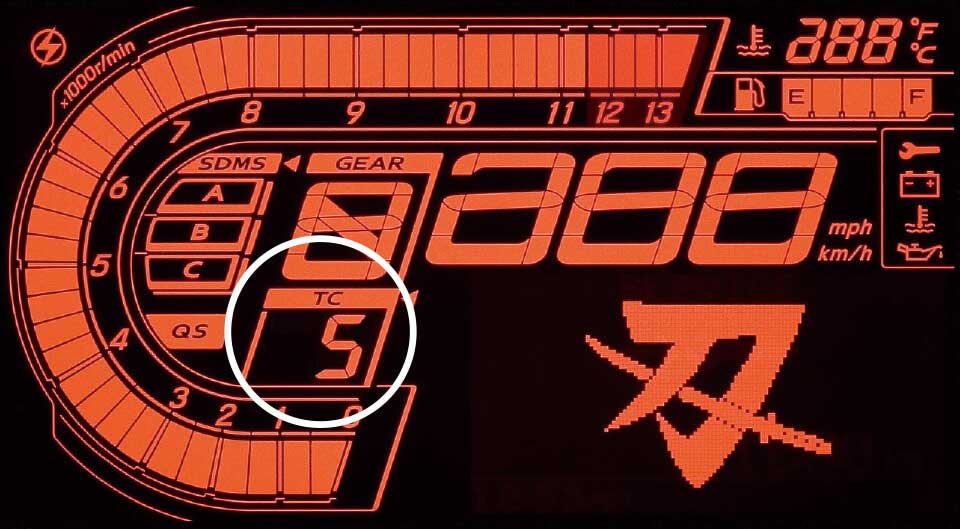
TC mode display
Suzuki Traction Control System (STCS)
The STCS has been updated from the previous generation’s 3-mode (+ OFF) version to now offer a wider selection of 5 mode settings (+ OFF). The new 5-mode traction control system allows for finer incremental control over settings, making it more adaptable to a diverse range of riding conditions and styles. As a result, riders, regardless of experience level, can feel more confident while reducing stress and fatigue. The higher the mode number, the faster the control takes effect and the more proactive the system is in limiting wheel spin.
Note: The Traction Control System is not a substitute for the rider’s throttle control. It cannot prevent loss of traction due to excessive speed when entering a turn and/or applying brakes. It also cannot prevent loss of grip in the front wheel.

QS mode display
Bi-directional Quick Shift System
This unique feature enhances the riding experience by allowing the rider to shift up or down smoothly without needing to use the clutch lever.
When activated by the rider, the system automatically interrupts power delivery for a brief moment while accelerating, resulting in smoother and almost uninterrupted acceleration when shifting up. Similarly, when decelerating, the system automatically increases rpm to match the engine speed with the next-lower gear ratio. This hands-free automatic blipping function seamlessly combines with engine braking to achieve highly satisfying downshifts.
The Bi-directional Quick Shift System works in conjunction with the SDMS power output mode settings, giving riders more flexibility to prioritize either sportiness or stability according to their style or current riding conditions. Additionally, it provides enhanced enjoyment while changing gears with a more linear shift feel.
Ride-by-wire Electronic Throttle System
The newly introduced electronic throttle control system utilizes the processing capabilities of a 32-bit ECM to regulate the movement of the throttle valves. This enables the implementation of various new electronic control systems that enhance rider confidence and further enhance the riding experience. As a result, the throttle action faithfully responds to the rider’s intentions, whether navigating city streets or embarking on an exhilarating sporty ride.

Ride-by-Wire Electronic Throttle System image
Low RPM Assist
This updated system utilizes TI-ISC (Throttle-body Integrated Idle Speed Control) to smoothly increase engine speed when releasing the clutch lever for launching from a standstill or riding at low speeds. This helps prevent engine stalls and ensures improved control and operation in stop-and-go traffic. It works in conjunction with the Suzuki Clutch Assist System (SCAS) to provide an even smoother and easier start from a standstill.
Suzuki Easy Start System
This system enables the rider to start the engine with one quick press of the starter button. There is no need to pull in the clutch lever when the transmission is in neutral, and the starter motor automatically disengages the instant the engine fires up. As a function used every time the engine is started, the system’s simplified operation makes riding all the more fun.

Suzuki Easy Start System Switch
The Design of the Suzuki Katana
The design of the Suzuki Katana was created by Hans Muth, a German designer who had previously worked for BMW. Muth wanted to create a bike that would stand out from other motorcycles on the market at the time. He drew inspiration from the traditional Japanese sword and incorporated many sharp angles and straight lines into his design.
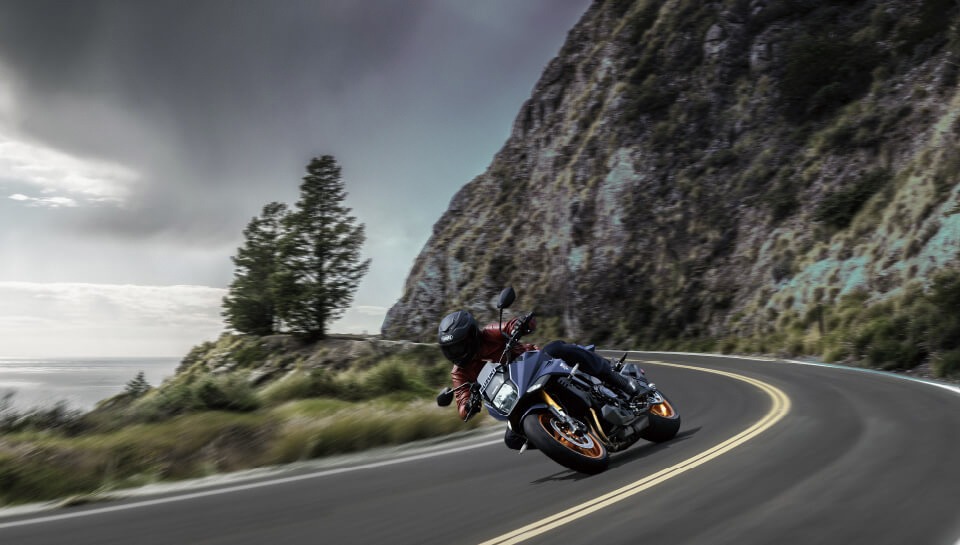
The bike’s distinctive style included a large fairing with an angular shape that extended over the gas tank and up over the handlebars. This gave the bike a futuristic look that was unlike anything else on the market at the time.
Engine Design
Tuned to deliver optimal performance on the street, the core architecture of this high-performance 999cm³ four-stroke DOHC liquid-cooled inline-four engine benefits from decades of expertise gained through winning numerous production races and from technologies developed for MotoGP racing.
Updates for the 2022 model year, including new camshaft profiles, valve springs, a clutch, and an exhaust system, further increase maximum power output and achieve a better overall balance of performance while still meeting BS6 emissions standards.

The air cleaner box incorporates an internal structure that effectively reduces intake resistance, thereby increasing power output. Although the new design slightly reduces the box’s volumetric capacity from 8.9L to 8.2L, it offers improved serviceability and reduced weight by eliminating the separator.
The updated engine not only features a broader and smoother torque curve with fewer peaks and valleys but also achieves greater cumulative torque production throughout its operating range. Furthermore, while the maximum torque is slightly lower than its predecessor, the engine generates more torque at low rpm, resulting in a more satisfying feeling of immediate response and acceleration at low speeds. Moreover, it demonstrates quicker response at mid-range and higher speeds, leading to a more exhilarating and enjoyable riding experience.
Maximum power output is attained at higher rpm (11,000 vs. 10,000), making opening the throttle and revving the engine even more enjoyable. These enhancements are complemented by a rich array of newly introduced electronic control technologies that enhance controllability, predictability, and reduce operator fatigue when operating the KATANA.

Engine cutaway

Exhaust system
The air cleaner box introduces an internal structure that effectively reduces intake resistance, contributing to increased power output. Although the new design slightly reduces the box’s volumetric capacity from 8.9L to 8.2L, it improves serviceability and reduces weight by eliminating the separator. The sporty 4-2-1 exhaust system for the 2022 KATANA retains the clean, sharp looks and luxurious note of its predecessor.
However, it has been completely redesigned and tuned to maximize overall performance while meeting BS6 emission standards. Structural changes include a new layout behind the collector, a new chamber structure, and the introduction of a two-stage catalytic converter system with an elliptical (“racetrack-shaped”) converter inside the chamber to ensure sufficient catalyst volume.
Additionally, the collector is slightly longer now, and the Suzuki Exhaust Tuning (SET) system is positioned differently. As an added benefit, Suzuki’s own Exhaust Sound Quality Evaluation Program was used to tune and optimize the exhaust note for this updated system. Through quantitative analysis and evaluation, this program achieves a pleasing exhaust sound that does not disturb the rider while riding but produces a luxurious note as soon as the engine starts.
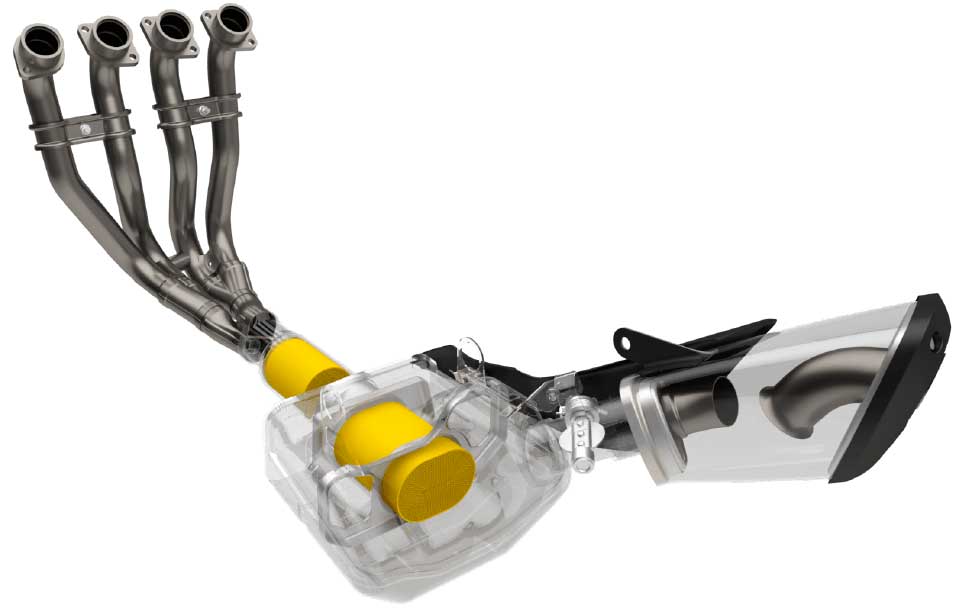
Electronic Throttle Bodies

The air cleaner box incorporates an internal structure that effectively reduces intake resistance, thereby increasing power output. Although the new design slightly decreases the volumetric capacity of the box from 8.9L to 8.2L, it improves serviceability and reduces weight by eliminating the separator.
In addition to satisfying BS6 emissions standards, the new electronic throttle bodies contribute to a better balance between idling speed control and power output characteristics for enhanced drivability and an exciting riding experience, thanks to their optimized Ø40mm bore size. This bore size is a change from the Ø44mm bore of the mechanical throttle bodies they replace.
The new electronic throttle system takes advantage of the processing capabilities of the 32-bit ECM to control throttle valve action and enables the integration of KATANA’s collection of new electronic control systems. One of many benefits is improved controllability when riders accelerate out of corners by opening the throttle.
Air cleaner box
The air cleaner box incorporates an internal structure that effectively reduces intake resistance, thereby increasing power output. Although the new design slightly decreases the box’s volumetric capacity from 8.9L to 8.2L, removing the separator enhances serviceability and reduces weight.
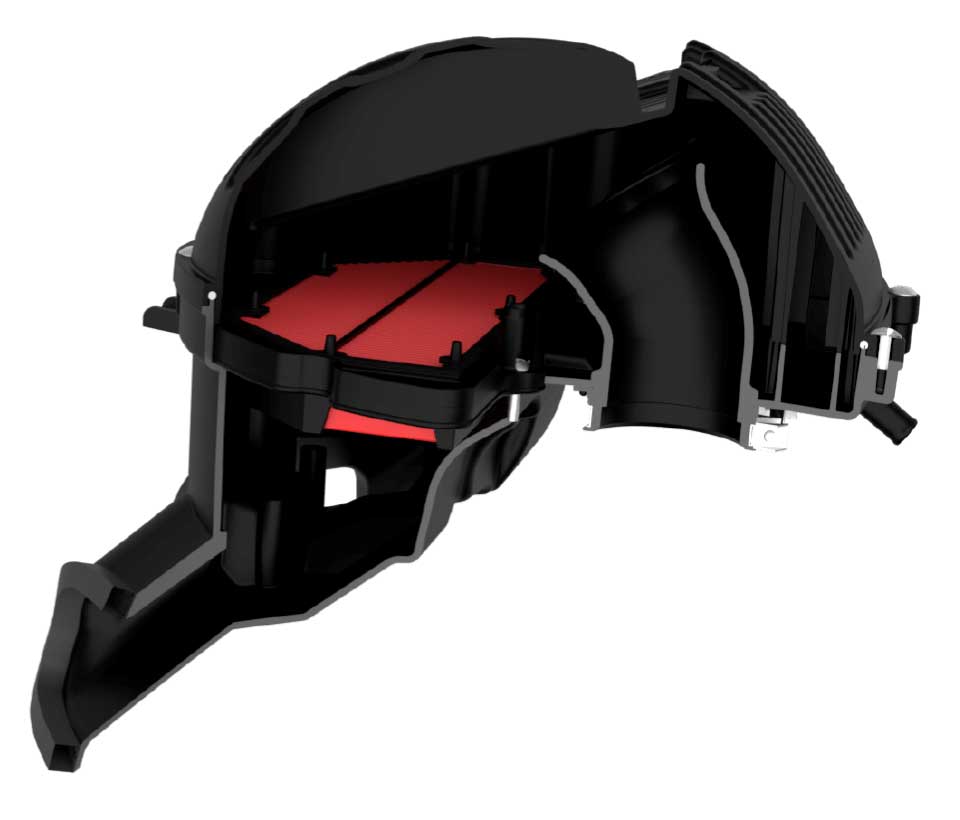
air cleaner box
Camshaft
A camshaft with carefully revised exhaust and intake cam profiles decreases lift and reduces valve lift overlap. This improvement helps enhance emissions performance while achieving a better balance of overall performance and controllability, especially at low- to mid-range speeds.


New camshaft
Radiator
The radiator features a new design that reduces airflow resistance by approximately 18%. This improvement significantly enhances cooling efficiency, resulting in a temperature reduction of approximately 1.5℃ during idling. Additionally, the radiator’s larger fin pitch aids in dissipating heat more effectively when the fans spin up, particularly in stop-and-go traffic situations.

Suzuki Clutch Assist System (SCAS)
The Suzuki Clutch Assist System (SCAS) for the 2022 KATANA introduces an assist function to complement the slipper clutch of the previous generation. The slipper clutch partially disengages when downshifting from high rpm to mitigate the effect of engine braking.
By reducing the chance of the rear tire locking up or hopping, and working in harmony with the Bi-directional Quick Shift System to achieve smoother deceleration, SCAS enables the rider to shift down with greater confidence and maintain better control while downshifting into corners.
The newly added assist function increases the clutch’s clamping force under acceleration, allowing for the use of softer springs while still effectively transferring torque to the rear wheel. This reduces the effort required to operate the clutch lever by approximately 20%, resulting in a lighter touch that alleviates left-hand fatigue during traffic jams or other situations that require frequent clutch lever operation.
Suzuki Clutch Assist System cam operation diagram

Chassis Design
The chassis of the vehicle has been carefully designed with several key objectives in mind. Firstly, it is compact and lightweight, which contributes to its overall agility and maneuverability. This makes it easier for riders to control the vehicle, enhancing their riding experience.

In addition to this, the chassis is engineered to provide a fun-to-ride character. This means that the vehicle’s handling is optimized to deliver an enjoyable and engaging riding experience. Whether navigating through city traffic, cruising on the highway, or tackling winding roads in rural areas, the chassis is designed to perform at its best in real-world riding conditions.



By focusing on these aspects of chassis design, riders can expect a dynamic and pleasurable riding experience across various road conditions and environments.
Performance of the Suzuki Katana
The performance of both versions of the Suzuki Katana was impressive for their time. The original Katana could reach speeds of up to 140 miles per hour (225 kilometers per hour). The GSX1100S version had even more power and could reach top speeds of around 150 miles per hour (240 kilometers per hour).
The bike’s handling capabilities were also noteworthy. It had a comfortable riding position and provided excellent stability on straightaways as well as in corners.
Legacy of the Suzuki Katana
The legacy of the Suzuki Katana has been long-lasting. Many consider it to be one of the most iconic motorcycles ever made. Its unique design has become legendary in motorcycle circles, and it stands out as a true classic.
The Katana also played an important role in the development of sportbikes. Its design influenced many other manufacturers, and its performance set the standard for what a high-performance motorcycle could be.
Modifications and Customizations
Due to its unique design and excellent performance, the Suzuki Katana has become a favorite among motorcycle enthusiasts who like to modify and customize their bikes. Some popular modifications include changing the exhaust system, upgrading the brakes or suspension, and adding custom paint jobs.
One popular customization is to convert the bike into a café racer style motorcycle. This involves removing unnecessary fairings and streamlining the bike’s design to give it a more classic look.
Collectibility of the Suzuki Katana
Due to its legendary status, original Suziki Katanas are highly sought after by collectors. The GSX1100S version is particularly valuable due to its rarity and superior performance.
In recent years, Suzuki has released new versions of the Katana that pay homage to the original design. These modern interpretations have been well received by both critics and enthusiasts alike, further cementing the legacy of this iconic motorcycle.
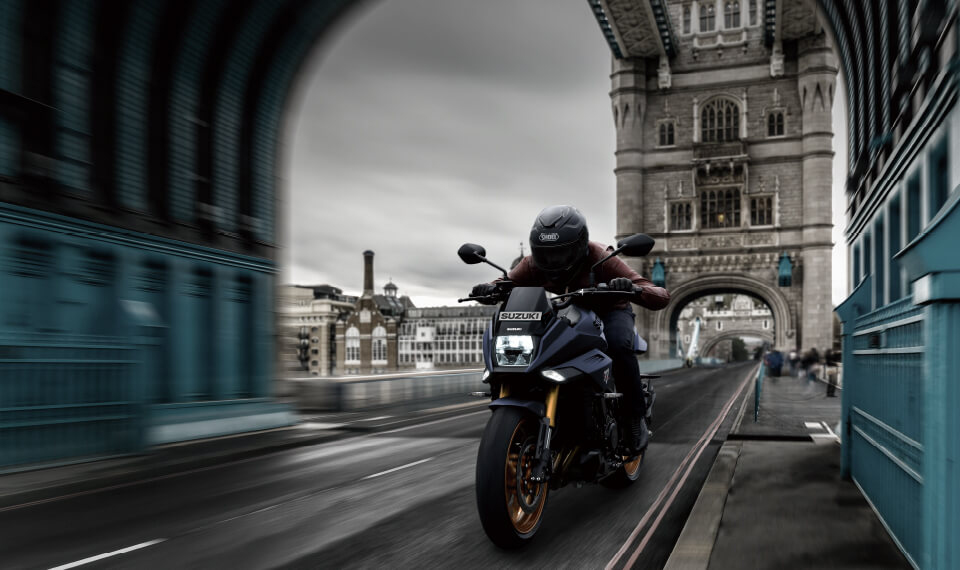
Electronic Design

Multi-function instrument cluster


All lights and indicators in the photo are illuminated for illustrative purposes.
The LCD instrument cluster offers a wide range of useful information in a compact form. It is designed to ensure easy recognition of the displayed information. The overall appearance exudes high quality, instilling a sense of pride in ownership.
The panel boasts a custom display with amber backlighting exclusive to the 2022 KATANA. This unique contrast allows clear visibility of lettering against the black background when riding at night, while appearing white during daylight for optimal visibility. When turning on the ignition key, a brief custom animation adds a playful touch that is visually pleasing and heightens anticipation for the ride ahead. Another update to the instrument cluster is the inclusion of the KATANA logo at the bottom, replacing the SUZUKI lettering from previous generations.
Flanking the display are LED indicators designed for easy recognition. These include indicators for turn signals, high beam, neutral, malfunction, master warning, ABS, traction control system, low voltage warning, coolant temperature, and oil pressure.
Highly functional and attractive lighting
LED headlight
The highly distinctive light beam of the vertically stacked LED headlight provides clear illumination and helps make the KATANA clearly visible to pedestrians and other traffic at night.
LED front position lights and turn signals
The clear white position lights and amber turn signals provide high visibility, durability and overall efficiency.


LED tail light and brake light
The distinctive design of these lights creates a sharp look, while the red LED lighting scheme provides high visibility, durability and overall efficiency.
LED rear turn signals
Mounted on the unique satellite rear fender that extends from the swingarm, these bright LED lights are highly visible and durable.
SPECIFICATIONS
ENGINE
| Engine Type | Four-stroke, liquid-cooled, DOHC, in-line four |
| Bore x Stroke | 73.4 mm x 59.0 mm (2.9 in x 2.3 in) |
| Displacement | 999 cm³ (61.0 cu. in) |
| Compression Ratio | 12.2 : 1 |
| Lubrication System | Wet sump |
| Transmission Type | 6-speed constant mesh |
DIMENSIONS & WEIGHT
| Overall Length | 2130 mm (83.9 in) |
| Overall Width | 820 mm (32.28 in) |
| Overall Height | 1100 mm (43.3 in) |
| Wheel Base | 1460 mm (57.5 in) |
| Ground Clearance | 140 mm (5.5 in) |
| Seat Height | 825 mm (32.5 in) |
| Kerb Mass | 217 kg (478.4 lbs) |
BRAKES
| Front | Disc brake, twin |
| Rear | Disc |
TYRES SIZE
| Front | 120/70ZR17M/C (58W), tubeless |
| Rear | 190/50ZR17M/C (73W), tubeless |
| Rake / Trail | 25° / 100 mm (3.9 in) |
SUSPENSION
| Front | Inverted telescopic, coil spring, oil damped |
| Rear | Link type, coil spring, oil damped |
ELECTRICAL
| Starter system | Electric |
| Ignition System | Electronic ignition (transistorized) |
FUEL TANK
| Fuel system | Fuel injection |
| Fuel Tank Capacity | 12.0 L (3.2 / 2.6 US / Imp) |
Personalize your ride
A lineup of custom accessories allows each rider to customize their KATANA to best express their personal tastes.


TANK PAD CARBON DESIGN

FUEL CAP PROTECTION STICKER

SIDE PROTECTION FOIL
Conclusion
The Suzuki Katana GSX1100 is truly one of a kind. Its unique design, impressive performance, and lasting legacy have made it an icon in the world of motorcycles. While original Katanas are difficult to find today, they remain highly sought after by collectors who want to own a piece of motorcycle history. If you ever get a chance to ride one of these legendary machines, take it – you won’t be disappointed!
Twiter: https://twitter.com/motoinworld2023
Instagram: https://www.instagram.com/motoinworld/







